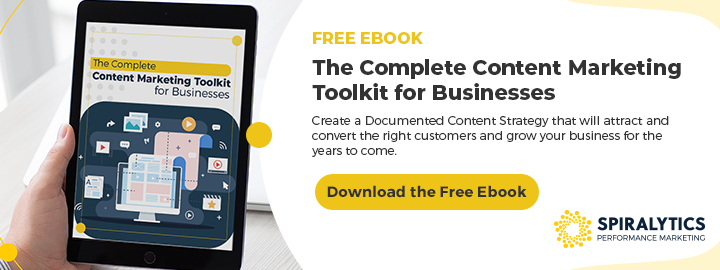Whether your audience prefers exclusive or publicly accessible content, we can help you design a winning content marketing strategy that drives engagement and profitable conversions for your business. Ask us about our customized content solutions today!
Gated content, freemium offers, content upgrades. Whatever you want to call them, the idea of creating lead magnets and gating them behind a signup form has been a core practice in content marketing for over a decade now.
After working with a variety of marketing partners as well as a wide range of B2B and B2C customers, we’ve come to realize that the opinions surrounding the concept of “gating content” are pretty polarizing.
On one hand, it’s a tried and tested tactic. Build an awesome piece of content that compels people to access it in exchange for their email address and grow your contact list for lead nurturing. It’s a great way to drive leads through your sales funnel and it still works today, which makes it pretty hard to argue against.
On the other hand, the marketing landscapes (both B2B and B2C) have dramatically evolved in recent years. For starters, consumers are far more empowered now, which means that marketers have had to adopt less intrusive ways to drive engagement. Traditional means of promotions became regarded as too salesy, too forceful, and downright manipulative. Not to mention the rising issue of online privacy and new government regulations like GDPR.
In reality, there are hugely conflicting opinions at both ends of the scale. So, we decided that the best way to reach a conclusion on this matter was to get insights from people doing the actual fieldwork for brands.
So, we figured this would make an excellent subject for a little debate.
We ran a survey and asked expert marketers from all backgrounds if they thought brands should be gating content in the modern age. Here’s what they had to say:
Many Still Use (and Love) Gated Content
- Mitchell Adams (VirtualRealityRental.co)
 Exclusivity can enhance the value of your asset but developing an annoying barrier may deter some potential new customers as well. The trick to gated content is to create relevant value offers and appealing calls to action that they can’t refuse.
Exclusivity can enhance the value of your asset but developing an annoying barrier may deter some potential new customers as well. The trick to gated content is to create relevant value offers and appealing calls to action that they can’t refuse.
Always leave them wanting more! If your business owns the proprietary data, show your audience its value with a brief synopsis then gate the rest. We develop, design, and gate some of our most valuable VR case studies and all we ask is that the user provides us with an email address in the pop-up form. If your form is too long and asking for too much, your information will never reach your audience.
This simple email exchange has been received well by our potential new customers and our industry-specific case studies are downloaded every week!
- Carlo Barajas (Surface SEO)
 Gated content still works, but the execution has evolved due to changing customer mentality. It used to be you gave visitors “basic” content that gave you general information, and they could pay for “premium” content that is more in-depth.
Gated content still works, but the execution has evolved due to changing customer mentality. It used to be you gave visitors “basic” content that gave you general information, and they could pay for “premium” content that is more in-depth.
Now, readers/potential customers have higher expectations of free content. To adapt, brands should be offering premium content for free, with the option to purchase “super premium” content. An example would be a course on starting an ecommerce business. The free content should tell readers everything they need to know in order to do it themselves. The “super premium” gated content would be something far more valuable: one-on-one consulting, access to a mastermind group, custom tools to help automate the most annoying parts of running a store.
Content and guides are everywhere, so to remain competitive and capture customer’s attention, brands need to offer things that can’t be found anywhere else.
- Chelsea Clarke (HerPaperRoute)
 Should marketers be using gated content for lead generation? In my experience, absolutely!
Should marketers be using gated content for lead generation? In my experience, absolutely!
Offering exclusive content (for free) in exchange for an email address is one of the best ways to build a relationship with your readers. After all, a blog visitor can come and go and be gone forever. A social follower probably doesn’t see everything you post online. A potential customer who didn’t buy your offer on the initial sales page is much more likely to make the purchase after they’ve warmed up to you via email. You really do need a way to ‘catch’ your site visitors, build a relationship and sell to them later. And gated content is the perfect way to do just that.
- Tim Brown (Hook Agency)
 I have been able to get amazing results by creating a really amazing piece of content, but then augmenting it even further with a download that a reader would certainly want. So once they’ve read 1,500+ words on the topic – the other half of the piece requires an e-mail, with a lead generation type form.
I have been able to get amazing results by creating a really amazing piece of content, but then augmenting it even further with a download that a reader would certainly want. So once they’ve read 1,500+ words on the topic – the other half of the piece requires an e-mail, with a lead generation type form.
We did this on our Analytics Basics guide, and Google Analytics’ twitter account even tweeted our guide! The first step is to make content that actually solves a problem, but still offers more value when they opt-in.
- Tom Buchok (MailCharts)
 When a potential client is reading “free” content on your site, then it illustrates their interest in your products or services, or at the very least, the niche in which you operate. However, there’s no great way to track that, unless the visitors are signing up for your newsletter along the way.
When a potential client is reading “free” content on your site, then it illustrates their interest in your products or services, or at the very least, the niche in which you operate. However, there’s no great way to track that, unless the visitors are signing up for your newsletter along the way.
So, utilizing gated content is the best way to verify who has visited your site to read that content. Once they submit their email address, you can follow up, or at least add them to your newsletter for bi-weekly or monthly updates. This qualifies the lead in a simple, effective way.
- Nicholas Farmen (Spire Digital)
 I have three reasons why brands should gate content that is intended for more qualified leads only. For one, you don’t need the contact information of random website users, and ‘brand awareness’ content should be shared and enjoyed by all.
I have three reasons why brands should gate content that is intended for more qualified leads only. For one, you don’t need the contact information of random website users, and ‘brand awareness’ content should be shared and enjoyed by all.
Second, you don’t want to waste the time of your sales team by bringing them leads that aren’t ready for a human touch, so again, brand awareness content shouldn’t be gated.
Third, you must gate your most valuable and solution-specific content because only the most qualified of leads are going to download or interact with this content. You want to engage these leads and know who these people are, so if you’re not gating your most valuable content, you’re losing out on important information.
- Andrea Loubier (Mailbird)
 Using gated content can help you to see who is genuinely interested in your business. Anyone can scan through a few articles via a quick Google search, but it shows an intent if the user is willing to input an email address.
Using gated content can help you to see who is genuinely interested in your business. Anyone can scan through a few articles via a quick Google search, but it shows an intent if the user is willing to input an email address.
Site visitors are savvy these days, and they understand that inputting an email address means that they’re likely to receive some form of email correspondence. So, if they are interested in the content enough to understand and agree to receiving additional emails, then that means that could prove to be a wonderful lead.
- Ben Taylor (Home Working Club)
 Gating off content is still a perfectly valid strategy for gathering leads and subscribers. The important thing is to ensure you deliver genuine value – and this means giving away something better than a reader will find for free elsewhere.
Gating off content is still a perfectly valid strategy for gathering leads and subscribers. The important thing is to ensure you deliver genuine value – and this means giving away something better than a reader will find for free elsewhere.
It’s rather cynical just to give away a glorified article, but handing out an eBook that provides a deeper dive, or perhaps some worksheets or similar can be a fair “quid pro quo.” It really comes down to being honest about whether you’re handing out something worthwhile.
Also Read: Facebook Content: Strategy Evaluation
Some Think Gated Content is Outdated
- Sean Pour (SellMax)
 No, they should not. In my opinion, individuals have a lot of mistrust in giving away their personal information online. I think using gated content hinders your reputation and makes potential clients/readers afraid of your brand as they’ll categorize you as a “spammer” or someone who is fishing for their contact information.
No, they should not. In my opinion, individuals have a lot of mistrust in giving away their personal information online. I think using gated content hinders your reputation and makes potential clients/readers afraid of your brand as they’ll categorize you as a “spammer” or someone who is fishing for their contact information.
If you’re a household name or a big brand already, I think you can use gated content. If people already trust you, you won’t lose them right away by trying to get their contact information. When I mean well established, I mean that the average person recognizes your name, which is not very many companies.
- Sam Williamson (Streaming Movies Right)
 I’m a firm believer that content is no longer as valuable as it once was. If anything there is too much content in the world these days. Plus, people are much more savvy about what sites and apps they give their personal details to. So the idea that you’d keep some of your content locked away – and that visitors would hand over personal details to access it – is slightly outdated in my opinion.
I’m a firm believer that content is no longer as valuable as it once was. If anything there is too much content in the world these days. Plus, people are much more savvy about what sites and apps they give their personal details to. So the idea that you’d keep some of your content locked away – and that visitors would hand over personal details to access it – is slightly outdated in my opinion.
I’d much rather give away all of my content for free through my website, then charge a premium if people want to discuss specific matters that aren’t covered in my published content. This model has been working for me pretty well.
- Yaniv Masjedi (Nextiva)
 Gated content does work in some contexts. Unfortunately, there are a whole lot more where it is damaging to customer experience.
Gated content does work in some contexts. Unfortunately, there are a whole lot more where it is damaging to customer experience.
Consider your goal as a marketer: to take people on a journey from zero brand awareness to ready for a sales call, as efficiently and enjoyably as possible.
With that end in mind, is gated content really the way to go in every scenario possible? What about when you load a new site to be *immediately* whacked with an opt-in? “Whoa!” Your first impression is that they’re greedy for your data.
That being said, if you’ve developed one outstanding piece of authority content that can serve as evergreen reference material, and you have the industry authority to command some kind of “buy in” from your audience, then by all means leverage that.
What we are really calling to issue here is anyone and everyone trying to charge a “door fee” before a visitor can even step inside to see if they want to leave some of the dollars with the establishment.
- Sean Dudayev (Frootful Marketing)
 For me gated content is a huge no. All it does is increase your bounce and allow your competitors to be more readily found and appreciated for their non-gated content. In 2019, content marketing is more competitive and gating your content will most likely cause you to lose more than you gain.
For me gated content is a huge no. All it does is increase your bounce and allow your competitors to be more readily found and appreciated for their non-gated content. In 2019, content marketing is more competitive and gating your content will most likely cause you to lose more than you gain.
The alternative to gated content is creating additional content that you can use for a lead magnet that can be seen as more valuable than the content that drove the visitor there. Perhaps its a “Part 2” or course on the subject you discussed briefly. Something like that can work, but gating your content altogether for the purpose of catching leads is likely to backfire.
- Marko Saric (MarkoSaric.com)
Coming from someone who’s created both gated and non-gated marketing content, I don’t think there’s a right or wrong answer to this question.
It all depends. I personally don’t use gated content too much anymore. It does boost the number of email leads you may get but it doesn’t necessarily correlate with the quality of those leads or with the actual bottom line results and ROI.
Non-gated content, on the other hand, has many benefits. People consume it openly, people engage with it and share it with their friends, and website owners link to it. This contributes a lot of value. Increased brand awareness, increased social media mentions, following and website traffic, long-term increase in Google rankings and organic search traffic, and it still does bring a decent number of leads too.
Some are Adopting a More Specific Approach to Gated Content
- Adam Gingery (Majux)
 Having a mix of gated and ungated content is usually the best way to go; you can attract more traffic with your ungated content, then present your premium gated content to those users once they are on your site.
Having a mix of gated and ungated content is usually the best way to go; you can attract more traffic with your ungated content, then present your premium gated content to those users once they are on your site.
That said, here’s one way to capitalize on the ungated route:
Once you have a flow of traffic to your site, you can remarket to them via Google Ads, Adroll, Facebook, etc. If you have the right tracking pixels on your site, each visitor essentially becomes a lead, and you don’t even have to collect their email address to get value from that visitor. We take a content-heavy approach to marketing for most of our clients, and we always remarket that audience (with great results).
If you want to produce gated content that can still rank on Google, you have two options: 1). Write a substantial introduction or section before the CTA, and optimize the title tag and h1, or 2). Let the content load first (so bots can crawl it), then utilize a Javascript popover to block, or “gate,” the content. Results vary with the latter, so test it at your own peril!
- Emma Valentiner (Lead Crunch)
Content gates – particularly in B2B marketing – are incredibly valuable for lead generation efforts, but often overused. You’ve got to be strategic. Know what specific info you need to gather – and have a plan for what you’re going to do with it. Email campaigns? Sales calls? Don’t gate until you have an established plan for what happens next.
Gate content that is on the far end of the middle of the funnel – trust should already be established before you ask for any contact information from a prospect. This means you should only gate high-value content like webinars, ebooks and whitepapers. Think about what type of content you’d be willing to exchange your information for – it’s likely not a blog post.
- Mike Kelsen (SEOgine)
 People are much smarter and savvy to these tactics, but it is still effective and a great way to build your lead funnel. There just needs to be a focus on quality versus quantity.
People are much smarter and savvy to these tactics, but it is still effective and a great way to build your lead funnel. There just needs to be a focus on quality versus quantity.
Providing a helpful article/blog that genuinely answers the question of the reader, “for free”, is a much better approach. In order to get the reader to give you their information, you need to offer something that is of value to them.
Example: Your article is about refinancing a home, tell them how to refinance your home, with no strings attached. Where you would add your lead magnet is by offering a refinance checklist and custom payment calculator in exchange for their info.
In summary, you should provide value to the reader upfront, gain trust, then offer and tangible resource for their personal information. So yes, it still work today and marketers should use it just as they have years before.
- Anand Iyer (Anand Iyer)
 When and how to put your content behind a lead capture form:
When and how to put your content behind a lead capture form:
1) If you have a large audience, great organic traffic and need to filter your audience.
2) If you want more marketing qualified leads.
3) If you want to gauge the level of interest in your content.
4) If the content you provide is premium(high value). The content shows all signs of being Empathetic – Authoritative – Trustworthy
When you should not gate the content:
1) If you want to build an audience i.e. generate brand awareness and reach
2) If you want to rank for quality keywords and boost your search engine optimization efforts.
3) if you want more customer engagement, interaction and content consumption at a higher level of the sales funnel(top of the funnel)
- Laura Troyani (PlanBeyond)
 We tell people that the underlying goal behind content creation should drive whether or not to gate it. If your content is strictly about new email acquisition, then gating is the way to go. Sure, it puts up a barrier to email capture and may result in bounces. But, for organizations that need to actively grow their database, it’s a time-tested way to do it. This is especially the case if you’re using paid tactics to drive net-new individuals to your content. You don’t want to spend money on that click and not get their contact info.
We tell people that the underlying goal behind content creation should drive whether or not to gate it. If your content is strictly about new email acquisition, then gating is the way to go. Sure, it puts up a barrier to email capture and may result in bounces. But, for organizations that need to actively grow their database, it’s a time-tested way to do it. This is especially the case if you’re using paid tactics to drive net-new individuals to your content. You don’t want to spend money on that click and not get their contact info.
In contrast, if you’re more focused on nurturing an existing contact database, then leave your content ungated. You already have individuals’ email addresses, if not more, so no barrier to content access is needed. While it’s true that you could use this as an opportunity to capture additional information about the visitor, there are enough other database field-building tools out there that let you do this behind the scenes without hampering the user experience.
- Jonathan Rodriguez (BitMar)
 In my experience, the freemium model may not always negatively impact the user-experience; but gated content may definitely be ‘a dead horse’. There is a big difference between the two.
In my experience, the freemium model may not always negatively impact the user-experience; but gated content may definitely be ‘a dead horse’. There is a big difference between the two.
The Freemium Model is Here to Stay:
Marketers can offer a freemium model that enhances the provided content, while not gating any content at all. Our streaming platform is a great example to this approach: The free and paid versions of BitMar offer access to the same content, while the paid version thereof enhances the offer.) In other words: a freemium model does not have to always be a fully-gated-content model.
Gated Content is Definitely Dead:
The situation is simple: There is simply too much free content out there. It will become even harder for gated content providers to justify their offerings, as time goes by; and even more content becomes readily available, at no cost. In my opinion, all gated-content marketers will have to — at some point — reconsider their business model. Those who pivot their monetizing strategies will survive. Those who do not, will simply go out of business.
- Virginia Case (STRATAC Marketing)
 Gating collateral or information about your business at the top of your sales funnel is like charging someone for your business card. It is just not a good idea. Offer enough high-value ‘free’ content to prospects that they will be willing to trade their contact information for more, potentially better, content that allows you to know more about them and where they are in the buying process.
Gating collateral or information about your business at the top of your sales funnel is like charging someone for your business card. It is just not a good idea. Offer enough high-value ‘free’ content to prospects that they will be willing to trade their contact information for more, potentially better, content that allows you to know more about them and where they are in the buying process.
We do not recommend that clients gate content until a prospect is in the right stage of the sales funnel to make it worthwhile for sales to follow up. Before deciding to gate a particular piece of content or content library, ask yourself if the reader will feel that the gated content is worth trading for their contact information.
Make sure that you offer enough value in your ‘free’ content to make them believe that your gated content will be worthy. Prospects will judge the possible value of the gated content by the quality of the ‘free’ content.
If your primary goal is high-quality leads and a larger list of contacts, then gated content makes sense. However, if your goals are brand awareness, reach and audience size, your focus should be on ungated content.
- Matt Slaymaker (Folsom Creative)
 Should brands utilize gated content? Short answer: It depends. Long answer: If your goal is lead generation, gating your high-quality content can be a great means of gathering relevant contacts.
Should brands utilize gated content? Short answer: It depends. Long answer: If your goal is lead generation, gating your high-quality content can be a great means of gathering relevant contacts.
If your goal is increasing traffic and climbing in the search engine rankings, you might not want to gate your content. Most users will not just give away their information. They need to be convinced that they will get something of value before giving away their data. This is where your free content comes in. By proving your worth through your free resources (blogs, tools, podcast) – you will drastically improve the likelihood that a user will give you their information.
Our agency has utilized both gated and non-gated content, using our blog to prove that we have valuable insights; and using the gated content to gather leads.
To Gate or Not to Gate?
Bottom line is, some brands use gated content while others don’t. And it seems to be working for players on both sides of the field.
Unsurprisingly, many brands are still using gated content to great effect. The nature of gated content’s lead capture mechanism gives brands an opportunity to start and maintain a dialogue with their sales prospects, which is undeniably important for lead generation.
As for those who’ve adopted a more open and free-sharing approach, they too have managed to drive success by enhancing the user experience of their sales funnel without necessarily sacrificing lead generation capabilities.
So, comparing the gated content landscape to that a decade ago, we can definitely notice that it’s nowhere near as popular of a tactic as it used to be. It’s far more common now to find brands leaning towards a “no strings attached” system for delivering content. And who’s to say they’re wrong when they can prove its worth with increased levels of engagement?
The concept of gated content is definitely losing traction in the modern marketing era, but rest assured, it will never die completely. The way we see it, as long as there are still prospects out there who appreciate the trust exchange that comes with accessing gated content, lead magnets will continue to be a valuable marketing tactic.
Which should you choose? Well, there’s no hard-and-fast rule. What it eventually comes down to is whether or not your audience actually appreciates it.
Here at Spiralytics, we use a mix of gated and ungated content to support our marketing objectives (about 10% gated and 90% ungated). We freely share blog and resource articles for maximum engagement and SEO impact. But, we also offer comprehensive eBooks for leads who want to take a deeper dive into a particular topic. This has continued to work for us in recent years and we can make it work for your brand, too!
Contact us today to find out more about how we can enhance your brand’s gated and ungated content!







